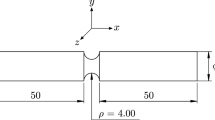Abstract
Fatigue-life tests were performed with notched bend specimens of ASTM A723 steel with three types of notch treatment and resulting residual stress; shot peening, hole swaging, and tensile overload. The three notch treatments produced widely different depths and surface values of residual stress near the notch root and different fatigue lives, depndent mainly on the notch root surface value of compressive residual stress. The highest life was measured from overload specimens, which had both the deepest and the highest surface-value residual-stress distribution.
Fracture-mechanics-based calculations of fatigue life agree well with measurements. The calculations account for the following factors which affect fatigue life: the crack-growth properties of the material; the shallow surface-crack configuration; the applied loading; and the depth and surface magnitude of the residual-stress distribution. A consistent description of fatigue life was obtained from a ΔK versus calculated life plot, where the ΔK is that for a shallow crack near the notch root and in the region of compressive residual stress. A power-law relationship between ΔK and life agrees well with the results from both the untreated notches and those with the three types of residual stress, indicating that life predictions could be made with some confidence for tests under generally similar conditions.
Similar content being viewed by others
References
Underwood, J.H. and Throop, J.F., “Residual Stress Effects on Fatigue Cracking of Pressurized Cylinders and Notched Bending Specimens,” Proc. 1980 SESA Spring Meeting, (May 1980).
Wohlfahrt, H., “Shot Peening and Residual Stress,” Residual Stress and Stress Relaxation, eds. E. Kula and V. Weiss, Plenum, 71–92 (1982).
Loomis, K., unpublished results, Army Armament RD&E Center, Watervliet, NY.
Underwood, J.H. and Kapp, J.A., “Benefits of Overload for Fatigue Cracking at a Notch,” Fracture Mechanics: Thirteenth Conference, ASTM STP 743, ed. R. Roberts, Amer. Soc. Test, and Mat., 48–62 (1982).
Underwood, J.H. and Throop, J.F., “Surface Crack K Estimates and Fatigue Life Calculations in Cannon Tubes,” Part-Through Crack Fatigue Life Prediction, ASTM STP 687, ed. J.B. Chang, Amer. Soc. Test. and Mat., 195–210 (1979).
Newman, J.C., Jr. andRaju, I.S., “An Empirical Stress-Intensity Factor Equation for the Surface Crack,”Eng. Fract. Mech.,15,185–192 (1981).
Benthem, J.P. andKoiter, W.T., “Asymptotic Approximations to Crack Problems,”Methods of Analysis of Crack Problems, ed. G.C. Sih, Noordhoff International, Leyden, The Netherlands (1972).
Parker, A.P. andUnderwood, J.H., “Stress Concentration, Stress Intensity and Fatigue Crack Growth Along Evacuators of Pressurized, Autofrettaged Tubes,”ARDEC Tech. Rep. TR-94046, US Army Armament Res., Dev. and Eng. Center, Watervliet, NY (1994).
Author information
Authors and Affiliations
Rights and permissions
About this article
Cite this article
Underwood, J.H. Residual-stress effects at a notch root in A723 steel to extend fatigue life. Experimental Mechanics 35, 61–65 (1995). https://doi.org/10.1007/BF02325836
Received:
Revised:
Issue Date:
DOI: https://doi.org/10.1007/BF02325836




